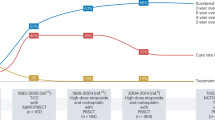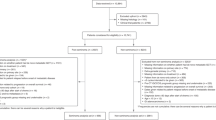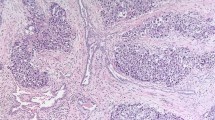Key Points
-
Metastatic testicular germ-cell tumours (TGCTs), in contrast to nearly all other cancers in adults, can be cured with drugs (cisplatin-based combination chemotherapy). But why are metastatic TGCTs so curable?
-
TGCT cells grown in the laboratory are 2–4 times more sensitive to cisplatin than most other types of cancer cell, so they provide a representative model system with which to study the mechanisms that control cisplatin sensitivity.
-
Testis tumour cells are deficient in one particular type of DNA repair — nucleotide excision repair — and consequently have a reduced capacity to repair the DNA damage caused by cisplatin.
-
Testis tumour cells are also defective in other aspects of DNA repair and are primed for apoptosis.
-
Targeting DNA-repair proteins might sensitize other types of cancer to cisplatin.
Abstract
Most metastatic cancers are fatal. More than 80% of patients with metastatic testicular germ-cell tumours (TGCTs), however, can be cured using cisplatin-based combination chemotherapy. Why are TGCTs more sensitive to chemotherapeutics than most other tumour types? Answers to this question could lead to new treatments for metastatic cancers.
This is a preview of subscription content, access via your institution
Access options
Subscribe to this journal
Receive 12 print issues and online access
$209.00 per year
only $17.42 per issue
Buy this article
- Purchase on Springer Link
- Instant access to full article PDF
Prices may be subject to local taxes which are calculated during checkout

Similar content being viewed by others
References
Souhami, R. & Tobias, J. Cancer and its Management 3rd edn (Blackwell Science, Oxford, 1998).
Parkin, D. M., Bray, F., Ferlay, J. & Pisani, P. Estimating the world cancer burden: Globocan 2000. Int. J. Cancer 94, 153–156 (2001).
Bosl, G. J. & Motzer, R. J. Testicular germ-cell cancer. N. Engl. J. Med. 337, 242–253 (1997). A clearly written review that summarizes most of the clinical aspects of TGCTs.
Pierce, G. B. & Speers, W. C. Tumors as caricatures of the process of tissue renewal: prospects for therapy by directing differentiation. Cancer Res. 48, 1996–2004 (1988).
Sell, S. & Pierce, G. B. Maturation arrest of stem cell differentiation is a common pathway for the cellular origin of teratocarcinoma and epithelial cancers. Lab. Invest. 70, 6–22 (1994).
Samuels, M. L., Lanzotti, V. J., Holoye, P. Y., Boyle, L. E. & Johnson, D. E. Combination chemotherapy in germinal cell tumors. Cancer Treat. Rev. 3, 185–204 (1976).
Einhorn, L. H. Curing metastatic testicular cancer. Proc. Natl Acad. Sci. USA 99, 4592–4595 (2002).
Einhorn, L. H. & Donohue, J. Cis-diamminedicloroplatinum, vinblastine and bleomycin combination chemotherapy in disseminated testicular cancer. Ann. Intern. Med. 87, 293–298 (1977). The landmark clinical study that demonstrated that TGCTs are curable with cisplatin.
Oosterhuis, J. W., Andrews, P. W., Knowles, B. B. & Damjanov, I. Effects of cis-platinum on embryonal carcinoma cell lines in vitro. Int. J. Cancer 34, 133–139 (1984).
Walker, M. C., Parris, C. N. & Masters, J. R. W. Differential sensitivities to chemotherapeutic drugs between testicular and bladder cancer cells. J. Natl Cancer Inst. 79, 213–216 (1987).
Pera, M. F., Friedlos, F., Mills, J. & Roberts, J. J. Inherent sensitivity of cultured human embryonal carcinoma cells to adducts of cis-diamminedichloroplatinum(II) on DNA. Cancer Res. 47, 6810–6813 (1987).
Fry, A. M. et al. Relationship between topoisomerase II level and chemosensitivity in human tumor cell lines. Cancer Res. 51, 6592–6595 (1991).
Parris, C. N., Arlett, C. F., Lehmann, A. R., Green, M. H. L. & Masters, J. R. W. Differential sensitivities to gamma radiation of human bladder and testicular tumour cell lines. Int. J. Radiat. Biol. 53, 599–608 (1988).
Masters, J. R. Human cancer cell lines: fact and fantasy. Nature Rev. Mol. Cell Biol. 1, 233–236 (2000).
Masters, J. R. HeLa cells 50 years on: the good, the bad and the ugly. Nature Rev. Cancer 2, 315–319 (2002).
Olie, R. A. et al. Apoptosis of human seminoma cells upon disruption of their microenvironment. Br. J. Cancer 73, 1031–1036 (1996).
Parris, C. N., Walker, M. C., Masters, J. R. W. & Arlett, C. F. Inherent sensitivity and induced resistance to chemotherapeutic drugs and irradiation in human cancer cell lines: relationship to mutation frequencies. Cancer Res. 50, 7513–7518 (1990).
Ishida, S., Lee, J., Thiele, D. J. & Herskowitz, I. Uptake of the anticancer drug cisplatin mediated by the copper transporter Ctr1 in yeast and mammals. Proc. Natl Acad. Sci. USA 99, 14298–14302 (2002).
Sark, M. W. J. et al. Cellular basis for differential sensitivity to cisplatin in human germ cell tumour and colon carcinoma cell lines. Br. J. Cancer 71, 684–690 (1995).
Masters, J. R. W. et al. Sensitivity of testis tumour cells to chemotherapeutic drugs: role of detoxifying pathways. Eur. J. Cancer 32A, 1248–1253 (1996).
Meijer, C. et al. Role of metallothionein in cisplatin sensitivity of germ-cell tumours. Int. J. Cancer 85, 777–781 (2000).
Walker, M. C. Inherent Sensitivity and Acquired Resistance in Human Testicular Germ Cell Tumours In Vitro. PhD Thesis, Univ. London (1990).
Köberle, B. et al. DNA repair capacity and cisplatin sensitivity of human testis tumour cells. Int. J. Cancer 70, 551–555 (1997).
Burger, H., Nooter, K., Boersma, A. W. M., Kortland, C. J. & Stoter, G. Lack of correlation between cisplatin-induced apoptosis, p53 status and expression of Bcl-2 family proteins in testicular germ cell tumour cell lines. Int. J. Cancer 73, 592–599 (1997).
Richards, E. H., Hickey, E., Weber, L. & Masters, J. R. W. Effects of overexpression of the small heat shock protein HSP27 on the heat and drug sensitivities of human testis tumor cells. Cancer Res. 56, 2446–2451 (1996).
Richards, E. H., Hickman, J. A. & Masters, J. R. W. Heat shock protein expression in testis and bladder cancer cell lines exhibiting differential sensitivity to heat. Br. J. Cancer 72, 620–626 (1995).
Hettinga, J. V. E. et al. Heat-shock protein expression in cisplatin-sensitive and-resistant human tumor cells. Int. J. Cancer 67, 800–807 (1996).
Lowe, S. W., Schmitt, E. M., Smith, S. W., Osborne, B. A. & Jacks, T. p53 is required for radiation-induced apoptosis in mouse thymocytes. Nature 362, 847–849 (1993).
Lowe, S. W., Ruley, H. E., Jacks, T. & Housman, D. E. p53-dependent apoptosis modulates the cytotoxicity of anticancer agents. Cell 74, 957–967 (1993).
Lutzker, S. G. & Levine, A. J. A functionally inactive p53 protein in teratocarcinoma cells is activated by either DNA damage or cellular differentiation. Nature Med. 2, 804–810 (1996).
Lutzker, S. G., Mathew, R. & Taller, D. R. A p53 dose-response relationship for sensitivity to DNA damage in isogenic teratocarcinoma cells. Oncogene 20, 2982–2986 (2001).
Kersemaekers, A. M. F. et al. Role of p53 and MDM2 in treatment response of human germ cell tumors. J. Clin. Oncol. 20, 1551–1561 (2002). A comprehensive analysis of the role of p53 in germ-cell tumours in relation to both cisplatin sensitivity and cisplatin resistance, plus a helpful review of p53 expression and some in vitro data.
Houldsworth, J. et al. Human male germ cell tumor resistance to cisplatin is linked to TP53 gene mutation. Oncogene 16, 2345–2349 (1998).
O'Connor, P. M. et al. Characterization of the p53 tumor suppressor pathway in cell lines of the National Cancer Institute anticancer drug screen and correlations with the growth-inhibitory potency of 123 anticancer agents. Cancer Res. 57, 4285–4300 (1997).
Burger, A. M. et al. Distinct p53-independent apoptotic cell death signalling pathways in testicular germ cell tumour cell lines. Int. J. Cancer 81, 620–628 (1999).
Brown, J. M. & Wouters, B. G. Apoptosis, p53, and tumor cell sensitivity to anticancer agents. Cancer Res. 59, 1391–1399 (1999).
Zamble, D. B., Jacks, T. & Lippard, S. J. p53-dependent and-independent responses to cisplatin in mouse testicular teratocarcinoma cells. Proc. Natl Acad. Sci. USA 95, 6163–6168 (1998).
Braun, R. E. Every sperm is sacred — or is it? Nature Genet. 18, 202–204 (1998).
Chresta, C. M., Masters, J. R. W. & Hickman, J. A. Hypersensitivity of human testicular tumors to etoposide-induced apoptosis is associated with functional p53 and a high Bax:Bcl-2 ratio. Cancer Res. 56, 1834–1841 (1996).
Arriola, E. L., Rodriguez-Lopez, A. M., Hickman, J. A. & Chresta, C. M. Bcl-2 overexpression results in reciprocal downregulation of Bcl-XL and sensitizes human testicular germ cell tumours to chemotherapy-induced apoptosis. Oncogene 18, 1457–1464 (1999).
Mueller, T. et al. Failure of activation of caspase-9 induces a higher threshold for apoptosis and cisplatin resistance in testicular cancer. Cancer Res. 63, 513–521 (2003).
Mayer, F. et al. Molecular determinants of treatment response in human germ cell tumors. Clin. Cancer Res. 9, 767–773 (2003).
Fink, D. et al. The role of DNA mismatch repair in platinum drug resistance. Cancer Res. 56, 4881–4886 (1996).
Mello, J. A., Acharya, S., Fishel, R. & Essigmann, J. M. The mismatch-repair protein hMSH2 binds selectively to DNA adducts of the anticancer drug cisplatin. Chem. Biol. 3, 579–589 (1996).
Massey, A., Offman, J., Macpherson, P. & Karran, P. DNA mismatch repair and acquired cisplatin resistance in E. coli and human ovarian carcinoma cells. DNA Repair 2, 73–89 (2003).
Zdraveski, Z. Z., Mello, J. A., Marinus, M. G. & Essigmann, J. M. Multiple pathways of recombination define cellular responses to cisplatin. Chem. Biol. 7, 39–50 (2000).
Takata, M. et al. Chromosome instability and defective recombinational repair in knockout mutants of the five Rad51 paralogs. Mol. Cell. Biol. 21, 2858–2866 (2001).
Vaisman, A., Masutani, C., Hanaoka, F. & Chaney, S. G. Efficient translesion replication past oxaliplatin and cisplatin GpG adducts by human DNA polymerase η. Biochemistry 39, 4574–4580 (2000).
Robertson, K. A. et al. Altered expression of Ape1/ref-1 in germ cell tumors and overexpression in NT2 cells confers resistance to bleomycin and radiation. Cancer Res. 61, 2220–2225 (2001).
Furuta, T. et al. Transcription-coupled nucleotide excision repair as a determinant of cisplatin sensitivity of human cells. Cancer Res. 62, 4899–4902 (2002).
Bedford, P., Fichtinger-Schepman, A. M., Walker, M. C., Masters, J. R. W. & Hill, B. T. Differential repair of platinum-DNA adducts in human bladder and testicular tumor continuous cell lines. Cancer Res. 48, 3019–3024 (1988). The first indication that NER was defective in TGCT cells.
Hill, B. T. et al. Deficient repair of cisplatin-DNA adducts in human testicular teratoma cell lines established from tumours from untreated patients. Eur. J. Cancer 30A, 832–837 (1994).
Köberle, B., Payne, J., Grimaldi, K., Hartley, J. & Masters, J. R. W. DNA repair in cisplatin-sensitive and resistant human cell lines measured in specific genes by Q-PCR. Biochem. Pharmacol. 52, 1729–1734 (1996).
Baxevanis, A. D. & Landsman, D. The HMG-1 box protein family: classification and functional relationships. Nucleic Acids Res. 23, 1604–1613 (1995).
Ohndorf, U. M., Rould, M. A., He, Q., Pabo, C. O. & Lippard, S. J. Basis for recognition of cisplatin-modified DNA by high-mobility-group proteins. Nature 399, 708–712 (1999). A key study showing the recognition of cisplatin-damaged DNA by high mobility group proteins.
Huang, J. C., Zamble, D. B., Reardon, J. T., Lippard, S. J. & Sancar, A. HMG-domain proteins specifically inhibit the repair of the major DNA adduct of the anticancer drug cisplatin by human excision nuclease. Proc. Natl Acad. Sci. USA 91, 10394–10398 (1994).
Zamble, D. B., Mu, D., Reardon, J. T., Sancar, A. & Lippard, S. J. Repair of cisplatin-DNA adducts by the mammalian excision nuclease. Biochemistry 35, 10004–10013 (1996).
Ohndorf, U. M., Whitehead, J. P., Raju, N. L. & Lippard, S. J. Binding of tsHMG, a mouse testis-specific HMG-domain protein, to cisplatin-DNA adducts. Biochemistry 36, 14807–14815 (1997).
Trimmer, E. E., Zamble, D. B., Lippard, S. J. & Essigmann, J. M. Human testis-determining factor SRY binds to the major adduct of cisplatin and a putative target sequence with comparable affinities. Biochemistry 37, 352–362 (1998).
Zamble, D. B., Mikata, Y., Eng, C. H., Sandman, K. E. & Lippard, S. J. Testis-specific HMG-domain protein alters the responses of cells to cisplatin. J. Inorg. Biochem. 91, 451–462 (2002).
Stoop, H. et al. Reactivity of germ cell maturation stage-specific markers in spermatocytic seminoma: diagnostic and etiological implications. Lab. Invest. 81, 919–928 (2001).
Köberle, B., Masters, J. R. W., Hartley, J. A. & Wood, R. D. Reduced repair of cisplatin-induced DNA damage in testicular germ cell tumours due to a specific protein defect. Curr. Biol. 9, 273–276 (1999). First unequivocal proof that NER is defective in TGCTs (earlier studies had used assays that required supralethal concentrations of cisplatin).
Chew, S. L., Baginsky, L. & Eperon, I. C. An exonic splicing silencer in the testis-specific DNA ligase III beta exon. Nucleic Acids Res. 28, 402–410 (2000).
Cleaver, J. E., Karplus, K., Kashani-Sabet, M. & Limoli, C. L. Nucleotide excision repair 'a legacy of creativity'. Mutat. Res. 485, 23–36 (2001).
Cree, I. A., Knight, L., di Nicolantonio, F., Sharma, S. & Gulliford, T. Chemosensitization of solid tumors by modulation of resistance mechanisms. Curr. Opin. Invest. Drugs 3, 634–640 (2002).
Middleton, M. R. & Margison, G. P. Improvement of chemotherapy efficacy by inactivation of a DNA-repair pathway. Lancet Oncol. 4, 37–44 (2003).
de Boer, J. & Hoeijmakers, J. H. J. Nucleotide excision repair and human syndromes. Carcinogenesis 21, 453–460 (2000).
Friedberg, E. C. How nucleotide excision repair protects against cancer. Nature Rev. Cancer. 1, 22–33 (2001). Comprehensive review relating NER defects to cancer predisposition syndromes.
Bramson, J. & Panasci, L. C. Effect of ERCC-1 overexpression on sensitivity of Chinese Hamster Ovary cells to DNA damaging agents. Cancer Res. 53, 3237–3240 (1993).
Larminat, F. & Bohr, V. A. Role of the human ERCC-1 gene in gene-specific repair of cisplatin-induced DNA damage. Nucleic Acids Res. 22, 3005–3010 (1994).
Ferry, K. V., Hamilton, T. C. & Johnson, S. W. Increased nucleotide excision repair in cisplatin-resistant ovarian cancer cells. Biochem. Pharmacol. 60, 1305–1313 (2000).
Cleaver, J. E., Charles, W. C., McDowell, M. L., Sadinski, W. J. & Mitchell, D. L. Overexpression of the XPA repair gene increases resistance to ultraviolet radiation in human cells by selective repair of DNA damage. Cancer Res. 55, 6152–6160 (1995).
Rosenberg, E., Taher, M. M., Kuemmerle, N. B., Farnsworth, J. & Valerie, K. A truncated human xeroderma pigmentosum complementation group A protein expressed from an adenovirus sensitizes human tumor cells to ultraviolet light and cisplatin. Cancer Res. 61, 764–770 (2001).
Reference deleted in proof.
Barret, J. M., Cadou, M. & Hill, B. T. Inhibition of nucleotide excision repair and sensitization of cells to DNA cross-linking anticancer agents by F 11782, a novel fluorinated epipodophylloid. Biochem. Pharmacol. 63, 251–258 (2002). Example of a new drug that targets NER.
Jiang, H. & Yang, L. Y. Cell cycle checkpoint abrogator UCN-01 inhibits DNA repair: association with attenuation of the interaction of XPA and ERCC1 nucleotide excision repair proteins. Cancer Res. 59, 4529–4534 (1999).
Fact Sheet. Twelve major cancers. Sci. Am. 275, 92–98 (1996).
Author information
Authors and Affiliations
Related links
Related links
DATABASES
Cancer.gov
LocusLink
OMIM
FURTHER INFORMATION
Glossary
- THIOLS
-
Compounds that contain -SH as the principal group directly attached to carbon, such as glutathione. Glutathione is the main endogenous antioxidant produced by the cell. It participates in the neutralization of free radicals, reactive oxygen compounds, and maintains exogenous antioxidants such as vitamins C and E in their reduced (active) forms. In addition, through direct conjugation by glutathione-S-transferase, glutathione detoxifies many compounds.
- CLONOGENIC ASSAY
-
Measures the proportion of single cells that are able to form colonies (minimum of 32 cells). It is used to estimate survival and dose response to drug treatment.
- ATOMIC ABSORPTION SPECTROSCOPY
-
This technique uses light absorption to measure the concentration of atoms in gas phase (usually following vaporization of a solid or liquid in a furnace).
- ALKALINE ELUTION
-
This technique measures the rate of DNA elution through a filter membrane under alkaline conditions. The amount of DNA single-strand breaks (or other lesions converted to single-strand breaks) is estimated on the basis of the increase in the rate of DNA elution.
Rights and permissions
About this article
Cite this article
Masters, J., Köberle, B. Curing metastatic cancer: lessons from testicular germ-cell tumours. Nat Rev Cancer 3, 517–525 (2003). https://doi.org/10.1038/nrc1120
Issue Date:
DOI: https://doi.org/10.1038/nrc1120
This article is cited by
-
A new function for drug combination dose finding trials
Scientific Reports (2024)
-
Evolutionary determinants of curability in cancer
Nature Ecology & Evolution (2023)
-
Strong apoptotic response of testis tumor cells following cisplatin treatment
International Urology and Nephrology (2023)
-
Shared and unique genomic structural variants of different histological components within testicular germ cell tumours identified with mate pair sequencing
Scientific Reports (2019)
-
Molecular Mechanisms of Cisplatin Chemoresistance and Its Circumventing in Testicular Germ Cell Tumors
Current Oncology Reports (2018)



